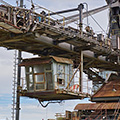AN OVERVIEW ON THE BASIC PROCESS OF MINING
September 10, 2015
Mining generally involves conducting a preliminary geological analysis of a perspective mining location through extraction, and reclamation. Mining explorations and operations have the potential to create severe negative safety, ecological, environmental, and economic impacts during the process and long after. Safety and environmental procedures and regulations are in place to mitigate contamination and other negative effects, and improve conditions for surrounding habitats, populations, and resources, as well as mining personnel.
TYPES OF MINING:
SURFACE MINING
Open pit, quarrying (of sand and stone), strip mining (to expose ore seams), landfill mining (excavated and processed landfills), and mountaintop removal (coal mining) are surface mining processes, which are performed by stripping surface soils, vegetation and bedrock layers to expose buried deposits.
SUBSURFACE MINING
The subsurface mining process involves excavated shafts and/or tunnels to reach and extract ore from found deposits. Ore is processed and waste-rock is disposed of. Shaft mining (vertical shaft access), drift mining (horizontal tunnel access), and slope mining (sloped shaft access) are subsurface mining processes.
ORE ROOM SUBSURFACE MINING
Shrinkage slope, long wall, and room and pillar mining processes involve creating underground mining rooms. Ore is removed from each braced / supported “room.” Supports and pillars are removed, allowing the area to cave in as miners leave and move forward. Hard rock subsurface mining involves bore-hole, drift-and-fill, sublevel and block caving, and long-hole slope mining techniques.
REGULATORY REQUIREMENTS
Due to the nature of mining processes and their impact on the environment, regulatory codes and procedures, permits, licenses, and equipment activity inspection and monitoring are essential during the mining operations and years after the mine has closed. Mining operations can produce (coal, timber, mine) fires, chemical spills, and hazardous debris in addition to:
- erosion and sinkholes,
- groundwater and soil contamination,
- surface water and water supply contamination,
- air pollutants (respiratory, skin, and organ deterioration), and
- compromised biodiversity.
Enforced local and federal environmental and reclamation and rehabilitation codes are intended to minimize environmental impact and protect human health and safety. Environmental impact assessments, management plans, mine exit and closure plan, and monitoring during and after the mine’ closure should be authorized, implemented, and revised as necessary to ensure safety and minimal impact.
THE MINING PROCESS
The process of mining progresses from discovery and geological analysis of the area (vein, seam, orebody, etc.), the subsequent physical exploration of the proposed mining area, extraction of the ore, minerals, or precious metals, etc., and reclamation of the mining site to its natural state. Steps in the mining process include:
1. Discovery, extent, location, and value of the ore body (prospecting, exploration);
2. Estimation of the deposit’s size and grade;
3. Pre-feasibility study (estimated investment, risks, potential for expanded study);
4. Feasibility study (financial, risks, feasibility, project reward);
5. Project decision (proceed or reject);
6. Proceed with the project; project planning including: the most economic method of ore recovery, marketability, engineering concerns, total costs and financing, etc.;
7. Consideration of the total movement and cost of waste removal plus ore material operation;
8. Construct mine buildings and processing plants;
9. Equipment is procured;
10. Mining operations proceed until all profitable ore has been mined.
PROCESSING MATERIALS
Mechanically extracted material is processed by washing or by crushing or grinding (subsurface mining) to separate valuable material from waste (gangue). Smelting or electrolytic reduction is used to further reduce metals to a “metallic form.”
The mining site/land is reclaimed to make it suitable for future use after all operations are completed.
Screening Technology Pty Ltd T/AS Hawk Machinery
Address: 7 Lantana St Blackburn North Vic 3130
Contact Person: Bohdan Blaszczyk
Phone: +61 3 9877 7777
Fax: +61 3 9877 8177
Mobile: 0411 099 989
Email: info@hawkmachinery.com.au
Optimized by NetwizardSEO.com.au
Optimized by: Netwizard SEO
